#Telemedicine software
Text
Health in the Digital Age: Patient Experience
Have you ever wondered what the meanings of some of those complicated technical words were?
Have you ever questioned what those baffling technological jargons can do for you?
Here are just a few very basic definitions that should help you understand a few of those concepts and what the experience might mean to you.
First off, it is not necessary to understand the what, when, why, or how a specific device or program accomplishes its goals. Most of us are capable of surviving on a "need to know" basis. In other words, leave the technical stuff to the professionals in that field. You and your doctor can concentrate on getting the best possible results and patient experience.
Digital: This is a format and method for electronic technology, also known as a "digital language," that can create, process, and store data and information. This format/process, also known as a binary code, converts data into readable, alpha-numeric information.
This method of information input and processing is more precise, easily readable, quick, and retrievable, and helps to make better, faster decisions, leading to detailed diagnoses like identifying the illness and consequently more accurate prognoses (outcomes/treatment). In comparison to traditional paper storage, this method uses less space and is better able to safeguard your private and confidential information.
Digital - Online: This term refers to a person (human) or an object (electronic device) that is linked to or operates via the internet.
This makes it possible to access information much more quickly.
Platforms are more user-connected because they typically call for and encourage some level of individualized user communication and interaction.
Digital platforms include, for example, shopping sites like Amazon and eBay, medical offices or clinics, nonprofit organizations, directories, information, research, student education, banking, and more.
An Internet/Web browser, also known as a "browser," is a program that accesses and displays websites using a piece of computer software.
You can travel almost anywhere on the internet using a web browser. On your desktop, mobile device, or other electronic devices, it displays information that has been retrieved from other areas of the World Wide Web. Microsoft Edge, Internet Explorer, Google Chrome, Mozilla Firefox, Opera, and Apple Safari are a few examples of web browsers.
A website is a collection of various web pages with information on one or more subjects linked together under the same domain name, as opposed to a web page, which is a single document on the internet with a specific URL.
a web page: These rely more on information and don't demand private information or one-on-one communication like a platform.
Using a web browser, you can go almost anywhere online. It shows data that has been retrieved from other parts of the World Wide Web on your desktop, mobile device, or other electronic devices. Web browsers include Microsoft Edge, Internet Explorer, Google Chrome, Mozilla Firefox, Opera, and Apple Safari, to name a few.
In contrast to a web page, which is a single internet document with a unique URL, a website is a collection of different web pages with information on one or more subjects linked together under the same domain name.
a website: Instead of requiring personal information or one-on-one communication like a platform, these rely more on the information.
Perhaps using a word symbol or visual aid will make the examples below easier to understand: For instance, the icon or symbol for a text/word document is a blue square with the letter "W" on it; the icon or symbol for WhatsApp is a white phone in a green filled balloon; the icon or symbol for Google Mail is a multicolored "M," and so on. These are made to simplify life for those of us who are less technologically savvy.
Hardware describes a computer's actual physical components. The central processing unit (CPU), also known as the computer's brain, hard drives, USB ports, keyboards, monitors, motherboards, and mice are examples of hardware components. The work is actually done by the hardware. Since the 1960s, hardware has undergone constant improvement, going from heavy, clunky devices to light-weight, portable modern digital gadgets like laptop computers, smartphones, medical equipment, tablets, etc. One of the key factors boosting the demand for technology devices is user-friendliness.
The term "software" describes the applications and other operating data that run on a computer. written originally in a digital (binary) format by computer programmers and used to provide instructions to the hardware of the computers. Applications, programs, and scripts that run on an electronic digital device are generally referred to as software. These instructions govern the work that the computer performs. Once more, user-friendly apps, programs, etc. are a major force behind the development of electronic devices for human use.
In terms of computers, a device is primarily defined as machinery with electronic or digital capabilities. The majority of us are familiar with these gadgets as computers, laptops, smartphones, watches, tablets, etc. Modern medical technology is one of those future paths that is constantly being explored, and the list gets longer and longer with every decade (or less) as the demand for modern technology rises in every aspect of our contemporary world.
Applications (abbreviated as "apps") are primarily made for the digital electronic devices mentioned in item #12 above. An app is a software program that can be downloaded to your devices and is paperless.
The user has a variety of options thanks to these apps. everything from games to studying languages, research, education at all levels, healthcare services, booking hotels, flights, and other travel arrangements, to communication and banking. An "app" has no restrictions on what it can do.
Technology today is similar to riding a bike or driving a car. It is not necessary to know how to make or repair it, but once you get the hang of using it, you will be enjoying a brand-new experience.
We hope that the terms mentioned above will increase your knowledge.
Our products are user-friendly, with simple-to-follow instructions and a logical flow of steps from one to the next. If you would like more information about how RioMed Ltd. can help you create a great patient experience, please get in touch with us or visit our website.
#Digital Healthcare#digital health#Healthcare#Health Care#online doctor consultation#online healthcare#Online doctor appointment#online doctor#electronic health records#website#electronic medical records#Telemedicine#Telemedicine Software#cellma#riomed#Healthcare IT#healthcare information#Hospital Information System#information technology
3 notes
·
View notes
Text
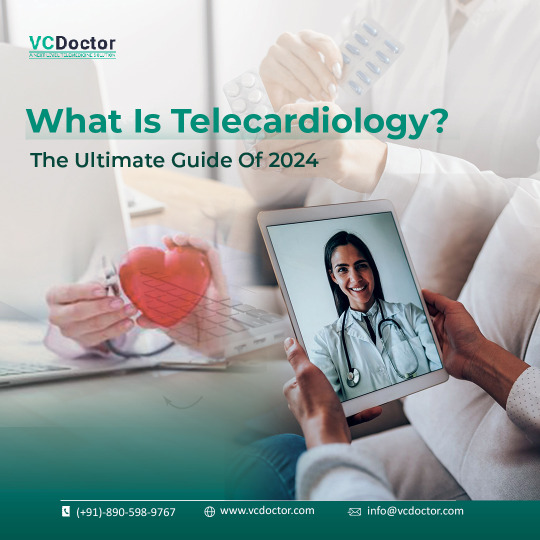
Every year we lose more than a million lives to heart diseases and ailments. But many of these deaths can be avoided! In most cases, a primary factor for death is a lack of late diagnosis and improper care. This is where Telecardiology steps in. Telecardiology services are a form of telemedicine. Think of it as a cardiologist seeing patients remotely using a web-based platform or a mobile app. These telemedicine platforms for providers offer features that make care accessible and cost-effective as well.
0 notes
Text
Vozo Telehealth
Telehealth refers to the use of digital healthcare technologies to provide healthcare services remotely. It encompasses a variety of services and applications, including virtual consultations, remote monitoring, telemedicine, and other forms of digital health. Telehealth has gained significant importance, especially in recent years, due to advancements in technology and the need for accessible healthcare services.
Virtual Consultations: Patients can interact with healthcare professionals through video calls, phone calls, or online messaging platforms. This allows for remote diagnosis, consultation, and follow-up care.
Remote Monitoring: Devices and sensors can be used to collect and transmit patient data, enabling healthcare providers to monitor vital signs, chronic conditions, and overall health remotely.
Telemedicine: This involves the use of technology to deliver medical services, including diagnosis and treatment, from a distance. It may include the exchange of medical information through secure platforms.
Mobile Health (mHealth): The use of mobile devices, such as smartphones and tablets, to support healthcare services, including apps for symptom tracking, medication reminders, and virtual consultations.
Store-and-Forward: Healthcare providers can securely share patient information, such as medical records, images, and test results, for consultation with specialists at a later time.
Benefits of telehealth include:
Increased Access: Telehealth makes healthcare services more accessible, especially for individuals in remote or underserved areas.
Convenience: Patients can receive medical care from the comfort of their homes, reducing the need for travel and saving time.
Cost-Efficiency: Telehealth can reduce healthcare costs for both patients and providers by minimizing the need for physical infrastructure and travel expenses.
Improved Monitoring: Remote monitoring of patients with chronic conditions allows for proactive care and early intervention.
Despite its advantages, telehealth also faces challenges, including issues related to privacy and security, regulatory considerations, and the need for reliable internet connectivity. As technology continues to advance and healthcare systems adapt, telehealth is expected to play an increasingly significant role in delivering healthcare services.
#Telemedicine#Telemedicine software#Telehealth#Telehealth software#cost effective telehealth solutions#Vozo telehealth#best telemedicine platform#HIPAA Compliant Telehealth#Telehealth EHR integration
0 notes
Text
The Future of Healthcare Exploring the Benefits of Telemedicine Software
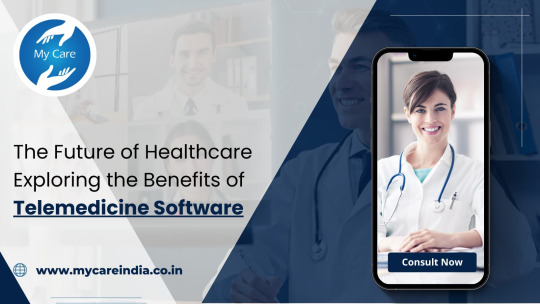
In a world marked by rapid technological advancements, the future of healthcare is evolving in exciting ways. One of the most transformative innovations in recent years is telemedicine software. This technology is reshaping the healthcare landscape, providing numerous benefits for both patients and healthcare providers.
Accessibility and Convenience: Telemedicine Software has opened the doors to accessible healthcare like never before. Patients no longer need to travel long distances or wait in crowded waiting rooms to see a doctor. With a simple internet connection, they can access medical consultations from the comfort of their own homes. This increased convenience is especially valuable for individuals with mobility issues, those in remote areas, or anyone seeking prompt medical advice.
Cost-Efficiency: Telemedicine can significantly reduce healthcare costs. Patients save on transportation expenses, and healthcare facilities can streamline their operations. Moreover, telemedicine reduces the likelihood of unnecessary emergency room visits, making healthcare more affordable for both patients and healthcare systems.
Improved Health Monitoring: Telemedicine software also enables continuous health monitoring, which is particularly beneficial for patients with chronic conditions. Wearable devices and remote monitoring tools allow healthcare providers to keep a close eye on patients' health parameters and intervene when necessary, reducing the risk of complications.
Enhanced Patient Engagement: Telemedicine software fosters better patient engagement. It enables easy access to medical records, test results, and treatment plans, allowing patients to take a more active role in their healthcare. This, in turn, can lead to improved health outcomes.
Conclusion: The future of healthcare is undoubtedly intertwined with Telemedicine Software. Its benefits, including improved accessibility, cost-efficiency, enhanced health monitoring, faster diagnosis and treatment, enhanced patient engagement. MyCare India is a telemedicine software platform that offers convenient and accessible healthcare services to patients and providers. With features like video consultations, secure messaging, and appointment scheduling, Streamlines the healthcare delivery process.
#telemedicine software#best E-healthcare app#e healthcare services#health care services#how mycare platform works#online doctor help
0 notes
Text
5 Ways Telemedicine is Revolutionizing Healthcare in the 21st Century
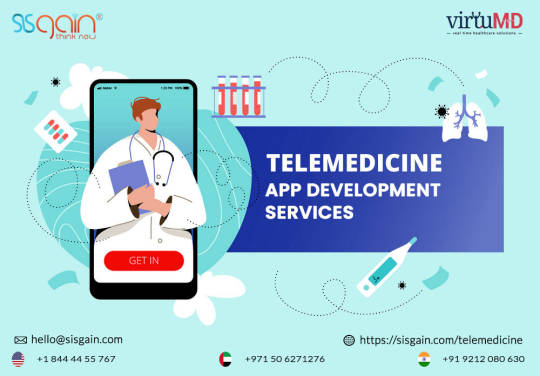
Telemedicine has been gaining increasing attention in the healthcare industry as a result of the COVID-19 pandemic. Many healthcare providers are turning to telemedicine to deliver care to their patients in a safe and efficient manner. The benefits of telemedicine are numerous and varied, and it is quickly becoming an essential part of modern healthcare. In this blog post, we will explore 5 ways telemedicine is revolutionizing healthcare in the 21st century and how companies like Sisgain are helping to drive this transformation through their telemedicine app and software development services.
Improved Access to Healthcare
One of the most significant ways telemedicine is revolutionizing healthcare is by improving access to care. Telemedicine eliminates the need for patients to physically travel to a healthcare facility, which can be especially beneficial for those who live in rural areas or have limited mobility. Telemedicine also allows healthcare providers to reach patients who may not have access to care due to distance, time constraints, or other factors. Companies like Sisgain are helping to facilitate this improved access to care by offering telemedicine app development services that enable healthcare providers to offer virtual consultations, remote monitoring, and other telemedicine services.
Increased Patient Engagement
Another way telemedicine is revolutionizing healthcare is by increasing patient engagement. With telemedicine, patients can take a more active role in their own healthcare by accessing health information, communicating with their healthcare provider, and monitoring their own health. Telemedicine apps and software can help patients stay engaged by providing them with access to educational resources, appointment scheduling, and medication reminders. By offering telemedicine app development services, companies like Sisgain are helping to facilitate this increased patient engagement and empower patients to take control of their own health.
Reduced Healthcare Costs
Telemedicine can also help to reduce healthcare costs by eliminating the need for costly in-person visits and reducing the need for expensive diagnostic tests. Telemedicine can also help to reduce the burden on healthcare facilities, which can lead to cost savings for both patients and providers. By providing telemedicine software development services, companies like Sisgain are helping to make telemedicine more accessible and affordable for both patients and providers.
Improved Efficiency and Productivity
Telemedicine can also improve efficiency and productivity in healthcare by reducing the time and resources required for in-person visits. Telemedicine apps and software can help healthcare providers manage their schedules, communicate with patients, and access patient information more efficiently. By offering telemedicine app development services, companies like Sisgain are helping healthcare providers to streamline their workflows and deliver care more efficiently.
Enhanced Patient Safety
Finally, telemedicine is revolutionizing healthcare by enhancing patient safety. By eliminating the need for in-person visits, telemedicine reduces the risk of infection and exposure to other illnesses. Telemedicine also allows healthcare providers to monitor patients remotely, which can help to identify potential health issues before they become more serious. By providing telemedicine software development services, companies like Sisgain are helping to ensure that patients receive the care they need in a safe and secure environment.
Conclusion
Telemedicine is revolutionizing healthcare in many ways, and companies like Sisgain are playing an important role in driving this transformation through their telemedicine app and software development services. By improving access to care, increasing patient engagement, reducing healthcare costs, improving efficiency and productivity, and enhancing patient safety, telemedicine is helping to make healthcare more accessible, affordable, and effective for patients and providers alike. As the healthcare industry continues to evolve, telemedicine is likely to become an increasingly important part of modern healthcare, and companies like Sisgain will be at the forefront of this transformation.
#telemedicine app development#telemedicine software development#telemedicine app development company#telemedicine software
0 notes
Text
Let's Talk Interactive Founder Honored in 2022 Most Admired CEO Awards
Let’s Talk Interactive Founder Honored in 2022 Most Admired CEO Awards
Arthur Cooksey, leader of an international telehealth solutions provider, nominated for his strong company vision and commitment to the Charlotte community
Press Release
–
Jun 13, 2022
CHARLOTTE, N.C., June 13, 2022 (Newswire.com)
–
Arthur F. Cooksey III has seen first-hand the challenges that rural communities face in accessing health care and mental health services, which drove him to…
View On WordPress
#HIPAA Compliant Websites#Patient Acquisition#telehealth solutions#telemedicine software#telemedicine solutions#Virtual Care Platform
0 notes
Video
Telemedicine Software Benefits for Patients
How can patients benefit from the telemedicine software? This video will walk you through the most important features of our telemedicine software and the ways by which you can benefit from them. From better coordinated medical care to top-notch customer support, our software offers it all. Watch the video to understand its significance better. For more information visit https://www.drcare247.com/telemedicine/
Contact Details:
Genix Technologies Inc
50 South Main Street, Suite 200
Naperville, IL
USA - 60540
Phone: 888 466 6066
https://www.drcare247.com/
0 notes
Text
Telemedicine, the Current COVID-19 Pandemic | Crescent Regional Hospital
Crescent Emergency Room is proud to offer exceptional 24-hour emergency care, with board-certified specialists catering to the communities of Lancaster, Desoto,
and our surrounding areas.
Emergency Room Services:
Open 24 hours a day, 7 days a week
30 minutes or less wait time
No appointment needed
Board-certified doctors
State-of-the-art medical equipment
All major insurances accepted
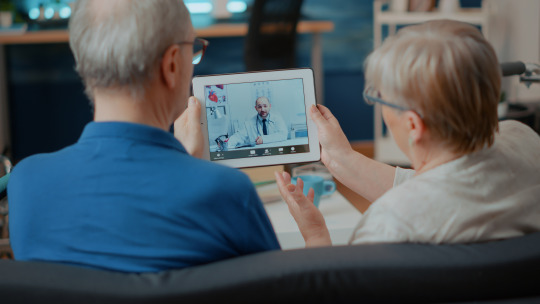
You can contact us on :- Phone : 1 469-297-5321
0 notes
Link
Mobile healthcare apps are more important than ever in streamlining the workflow of healthcare providers.
Software development for healthcare app like Telemedicine app development solutions, and telehealth app development are some trending solutions in healthcare software development.
#healthcare software development#healthcare app development#healthcare#Healthcare Application Development#healthcare software solutions#Telemedicine#telehealth#Digital Transformation#healthcare technology#technology#healthcare trends#trends
2 notes
·
View notes
Text
What is a Dialysis Information Management System and how does it work?
RioMed Limited was founded as a management consulting firm on November 19, 1997. RioMed Limited was founded on the fundamental tenet of “Working to Improve Healthcare.” RioMed’s knowledge of software solutions ensures efficient practice management. Cellma, the clinical software developed by RioMed, has proven to be a valuable healthcare information system that can be customized and tailored to the needs of any healthcare organization. The multifaceted approach of Cellma assists any healthcare organization in meeting the needs of various facets.
Last week’s article went into great detail about Diabetes Management. Diabetes is the leading cause of kidney disease, so the two are inextricably linked. One in every three diabetic adults has kidney disease. High blood glucose, also known as blood sugar, can harm your kidney’s blood vessels. Blood vessels that are damaged do not function properly. Many diabetics develop high blood pressure, which can harm their kidneys and lead to kidney failure. Dialysis is advised for patients who have kidney failure.
What exactly is dialysis?
According to the NHS, dialysis is used to remove waste products and excess fluid from the blood when the kidneys stop working properly. It frequently entails redirecting blood to a cleaning machine. This usually occurs when you have only 10 to 15% of your kidney function remaining. The kidney normally filters the blood, removing harmful waste products and excess fluid and converting it to urine, which is then excreted from the body.
Kidney dialysis is divided into two types: hemodialysis, which uses a special filter to purify the blood, and peritoneal dialysis, which uses a tube in the stomach and a special membrane to filter blood.
Blood flows slowly through a special filter during hemodialysis, removing waste and fluid before returning clean blood to the body. This dialysis treatment aids in the control of high blood pressure and the balance of chemicals in the body, such as potassium and sodium. Once a month, the blood will be tested to ensure that the dialysis treatments are effectively removing waste from the blood.
In contrast, a soft plastic tube (catheter) is inserted into your stomach during surgery in Peritoneal Dialysis. This catheter is used to insert a sterile cleansing fluid into your stomach. The fluid exits your body via the catheter after the filtering process is completed.
What role can technological interference play in dialysis management?
Only dialysis doctors and caregivers understand how meticulously kidney patients are treated. Both nephrologists and nurses in dialysis centers face the challenge of providing dependable and efficient care by clinical guidelines. Because practitioners don’t have to spend as much time maintaining control over healthcare practices, all-in-one software helps to deliver quality care to every patient.
The digitalization of dialysis is one of the most recent medical developments. Technological interference enables task automation, allowing doctors and nurses to devote more time to individual patient care.
Thus, the most compatible system designed for comprehensive data collection and medical information is Dialysis Software. It simplifies the Dialysis specialty hospital workflow and makes doctors’ lives easier (nephrologists). Because doctors can now focus on treating patients rather than maintaining control over healthcare practices, the all-in-one software helps to deliver quality care to every patient.
Dialysis software is responsible for managing patient data such as dialysis routines, documentation, and data storage. With a few clicks, it assists healthcare professionals by making dialysis treatments safer and more efficient. Machine integration enables the quick exchange of data between devices, as well as the generation of personalized bills and the management of subsequent patient visits. Digital software expedites the process while also vastly improving healthcare practices and treatment quality. The most important factor in providing enhanced patient care as a continuous care system is sharing real-time information and managing subsequent patient visits.
How do Patients Benefit?
Three to five hours of hemodialysis is usually performed three times per week. Dialysis patients can read, watch TV, sleep, or do other things while receiving treatment. To accommodate these lengthy treatment sessions, patients’ schedules must be adjusted. To establish a regular schedule, most patients prefer to have their treatments done at the same time.
The software system is extremely beneficial to doctors in assisting them with digital moves for healthcare practice management. It aids in the improvement of control and the acquisition of real-time reporting. An auto-generated prescription, digital billing, and auto-generated reports are provided to a patient, resulting in increased staff productivity and the elimination of time-consuming manual scheduling.
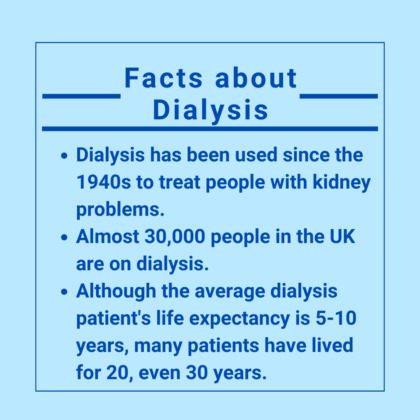
Dialysis Software Benefits:
The following are some of the most noticeable characteristics:
Getting Patients Registered Electronic Prescriptions
Dialysis Visit Schedule
Dialysis Treatment Plan Sheets
Barcode integration
Appointment Scheduling with Barcode Integration
Appointment Scheduling Discharge Summary
Notification via SMS/emails
Information Reports
Patient Records
About Cellma’s Dialysis Management Software
Cellma, RioMed’s powerful software solution, possesses these characteristics. Cellma oversees the entire dialysis patient experience, from referrals to appointments and scheduling. The modularly built one-patient, one-record system stores all data in one location, ensuring accessibility and consistency. Cellma integrates with technology and other systems to provide real-time patient statistics and alerts for treatment and patient monitoring. RioMed’s solutions are compatible with a wide range of devices, including laptops, desktop computers, and smartphones. Cellma’s pre- and post-dialysis assessments were created specifically for use in clinics to promote self-triage.
Many of these modules and functionalities are integrated into a single software with Cellma, ensuring efficiency in dialysis practice. You should also check out our other blogs and products. For more information, please contact us.
#Telemedicine#Telemedicine Software#dialysis#dialysis software#kidney#diabetes#electronic health record#electronic medical record#electronic medical records#electronic health records#Healthcare#Health Care#Hospital Information System#hospital management software
0 notes
Text
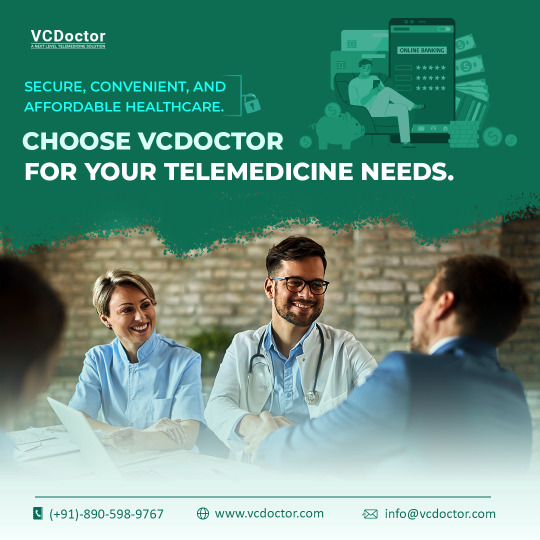
VCDoctor is a seamlessly integrated telemedicine solution that adheres to HIPAA compliance enabling doctors to diagnose and treat patients without the constraints of time and location. This platform represents a financially viable and meaningful endeavor for healthcare professionals, empowering them to deliver value-driven healthcare services.
0 notes
Text
Telemedicine Software | MyCare India

MyCare India offers cutting-edge telemedicine software, connecting patients with healthcare professionals for remote consultations, making healthcare accessible from the comfort of your home.
For More Information:- https://www.mycareindia.co.in/how-it-works/
#telemedicine software#best E-healthcare app#e healthcare services#health care services#how Mycare platform works#online doctor help
0 notes
Text
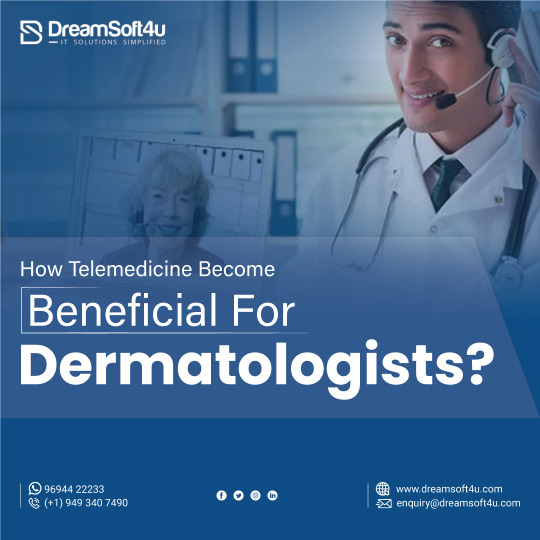
Telemedicine technology plays a significant role in modern dermatology as it leverages telecommunication technology. It promotes remote medical diagnosis and analyzes symptoms. Further, it conducts detailed consultations, and plans tailored treatments. Telehealth dermatologists offer patients high-quality care, regardless of geographical location using dermatology telemedicine systems.
#telehealth dermatology#telemedicine dermatology software#dermatology telemedicine systems#telemedicine app development#telemedicine software development
0 notes